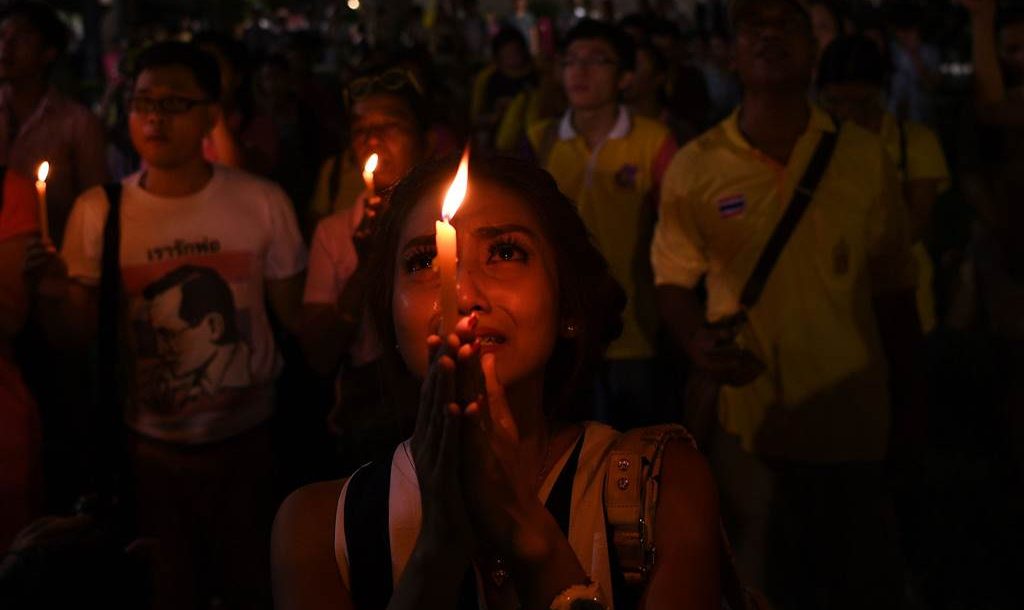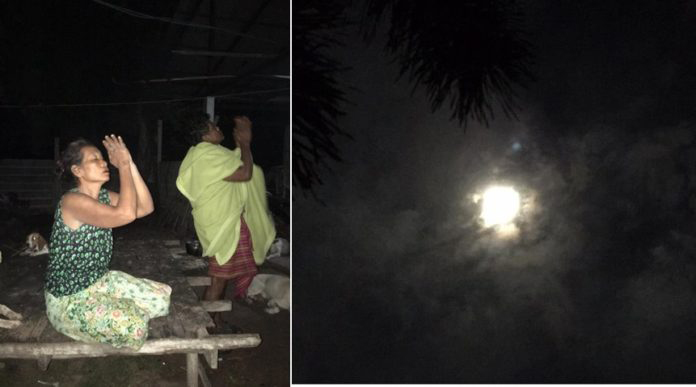Traditional understandings of divine kingship in Thailand could make a dramatic return following King Bhumibol’s death, writes Edorado Siani.
The epochal announcement was almost understated. The anchorman carefully spelled out King Bhumibol’s long ceremonial name, paused, and then firmly added ‘has reached the heavens’ (sawan-khot) – an expression taken from the linguistic register reserved for cosmologically-high beings like monarchs.
Later that night – the night of October 13 – prime minister and military strongman Prayuth Chan-ocha announced that Crown Prince Vajiralongkorn would replace his father on the throne. He powerfully ended his address with a formula, also articulated in the celestial jargon of royal Thai (rachasap), which may be translated as ‘long live the [new] king’.
Much of the recent coverage of King Bhumibol’s death has qualified the late monarch with titles including ‘divine king’, ‘semi-god’ and ‘demi-god’. Such attributes resonate well with ancient Thai cosmological treaties. But to what degree was/is King Bhumibol actually considered a celestial being in contemporary Thai society?
According to ‘traditional’ cosmological narratives, a monarch, sat on his throne at the Grand Palace, is (at) the center of the universe, receiving power/potency – usually in the form of merit (barami) – from the heavens, and irradiating it out to the rest of the kingdom. This power/potency brings life, order, civilisation, technology and all sorts of good things to the population, and, as a result, the soil becomes fertile and society prospers.
Power/potency is often described as a cone of light originating from the skies above the Palace, which illuminates with greater strength those that are nearer to it and which becomes increasingly feebler as one departs from it. The strength of the light and its effectivity at illuminating the entire kingdom is thought to depend on the levels of morality of a monarch.
While such ‘textbook’ notions of kingship are generally known in Thai society, perceptions of their validity in the ‘real world’ vary greatly. The supposedly predominant designation of the Thai king as a ‘supposed deity’ (samuthi-thep) is ambiguous, and different people interpret it in different ways, some advancing that the king is/was an actual celestial being and some arguing that he in fact is/was a person ‘like us’.
A plurality of voices is predictable, given the great number of sources of knowledge – school teachers, university professors, medical doctors, engineers, monks, diviners, Brahmins, writers, documentarists, and so on – that contemporary Thais can avail themselves of as they build their own understandings of the cosmos.
Divergences concerning the cosmological status of the monarch do not seem to correspond to opposing factions in the ongoing political standoff either, nor to affect membership to those more radical elements of society that various administrations over the past decade have attempted to put down through an unprecedented deployment of the lèse majesté law.
In recent times, the Thai state has indeed even demonstrated willingness to dialogue with the most ‘secular’ understandings of kingship, at times explicitly stressing King Bhumibol’s human rather than divine status. Little does the late monarch’s place on the human-to-celestial hierarchy seems to matter, as long as his work for his subjects – and, therefore, his status as an exceptionally meritorious leader – is not questioned.
After all, while the idea of a king spreading out power/potency/barami to people and soil by simply sitting on his throne may not appeal to contemporary sensitivities, the notion that a meritorious leader must prove his legitimacy by dedicating himself to the wellbeing of his followers keeps on playing a fundamental role among Thai Buddhists.
The cosmological role of the Grand Palace also seems to have lost some of its importance in recent times. While the temple of Wat Phra Kaew, contained within the Palace complex, is still greatly regarded as the most sacred monastery in the land, nobody really speaks about the Palace as the centre of the cosmos.
The late king’s choice of spending his life between another Bangkok-based palace – Chitralada – and his residence at the beachside city of Hua Hin suggests a lack of interest in strictly replicating the ‘traditional’ order. The long periods spent at Siriraj Hospital in Bangkok during the final years of his life may have further contributed to a certain disorientation with regards to the location of the ultimate seat of power/potency.
Quite remarkably, the monarch’s death may have revived some of the most ‘traditional’ cosmological notions that had otherwise seemed to have lost their appeal in recent times.
From the point of view of ‘traditional’ cosmology, the death of King Bhumibol meant that the source of power/potency that illuminated the country for seven decades suddenly extinguished. The resulting blackout appears to have been enacted visually by part of the population, which turned to wearing black. Such dress code is not the norm in these occasions; although the custom is not uniformly observed, mourning for a senior individual usually commands wearing white in Thailand. The resulting darkness was also signaled by the numerous media outlets that went from color to black and white. Even the screens of televisions, tablets and mobile phones for sale at some shopping malls were turned to black and white.
The night of the monarch’s death, people in at least two different locations identified King Bhumibol’s face shining down on them, written with thin clouds on a full moon. Photographs of two different instances of such sights – and of people promptly prostrating under the moonlight – were shared on social media and then published on Thai newspapers.
This may suggest that, as the empty throne left a void in the terrestrial cosmological centre of power/potency, people found an alternative one, displaced from this world but located in the near skies where the late monarch was thought to be. Total darkness, after all, belongs to the unknown, and the unknown causes anxiety.
The following day, as the body of the late king was being prepared at Siriraj Hospital in order to be brought to the Grand Palace following ritual protocol, a cascade of sunrays was photographed breaking through the clouds above the hospital. The image, which was again shared widely, suggested a connection between the heavenly location of King Bhumibol and his terrestrial remains, potentially making the latter a new medium for power/potency.
That night, after the late king’s body was brought to the Grand Palace, where it will stay for months until the final cremation, a new phenomenon was documented. The moon – just above the Grand Palace – was this time eclipsed, first by a heart-shaped cloud, and then by one shaped like the Thai numeral for nine – the auspicious number in Theravada Southeast Asia as well as the number that symbolizes King Bhumibol, the ninth king of the Chakkri Dynasty.
The undoubtedly reassuring sight may indicate that, at that point, the power/potency emanated by King Bhumibol was no longer in the skies, but that it was brought back, through his body, on earth, finally reuniting the monarch with the Grand Palace, and re-establishing the latter as the upmost terrestrial centre.
Since then, the white walls of the Grand Palace have been illuminated, and the complex shines bright in the darkness of the surrounding urban landscape, as numerous photographs that have again ended up on the Internet show.
Huge crowds that only seem to grow in number are flocking every night to the old centre of the cosmos to render homage to King Bhumibol. Many share black and white images of such gatherings that highlight the brightness of the Palace in comparison to their dark clothes and heads.
As people leave flowers at the feet of the Palace, they prostate the way they normally do when asking from blessings/power/potency from a higher being. Some highlight the physical transfer of power/potency from the Palace into their body by placing a hand against its walls; a few go as far as pressing their head against the walls, reminding of the ‘traditional’ accumulation of power into one’s head (the centre of power within the micro-cosmos of the human body) following an interaction with a deity.
The Thai junta, which may be considering ways to downplay the temporary vacuum in power caused by a delayed succession, seems to be finding it beneficial that these popular rituals keep the flow of power/potency from the Crown alive. Indeed, they have encouraged citizens to send them photographs of such events, which will eventually be turned into a publication.
In a rather unexpected turn, the emergence of new forms of rituals following the death of King Bhumibol therefore seem to be paving the way for some elements of ‘traditional’ cosmological understandings of divine kingship to make a dramatic return. The degree to which this apparent revival may be temporary, the degree to which it may involve more or less important chunks of the population, and the degree of innovation and departure from past cosmological model remain of course to be established.
Edoardo Siani (SOAS, University of London) is an anthropologist studying the politics of Buddhist cosmology and divination in contemporary Thailand.
 Facebook
Facebook  Twitter
Twitter  Soundcloud
Soundcloud  Youtube
Youtube  Rss
Rss 
